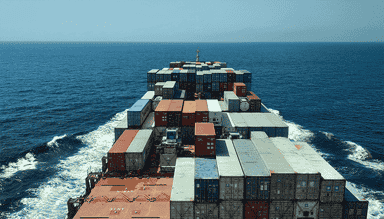
Revisting Podman
Although it’s been some time since I’ve worked with containers on my local machine, I recently found myself intrigued to discover what’s new with Podman.
Setting Up Podman
To kick things off, we’ll need to get Podman installed. As my development environment is running on a Mac M2, I’m going to employ Homebrew for this purpose:
``` shell$ brew install podman podman-compose podman-desktopIn addition to Podman itself, I've also chosen to install Podman Compose and Podman Desktop. The former serves as a fitting replacement for Docker Compose, allowing for the definition and orchestration of multi-container applications within the Podman environment. On the other hand, Podman Desktop is a handy GUI for Podman that substitutes Docker Desktop.
Following the successful installation, you can get Podman up and running with the subsequent command:
```bash frame="terminal" title="Start Podman"``` shell$ podman machine init$ podman machine startThis process will essentially download, install, and kickstart a qemu virtual machine designed to run Podman, mirroring the mechanism employed by Docker Desktop.
Upon successful installation, you should encounter an output akin to this:
```bash frame="terminal" title="Up and running"Starting machine "podman-machine-default"Waiting for VM ...Mounting volume... /Users:/UsersMounting volume... /private:/privateMounting volume... /var/folders:/var/folders
This machine is currently configured in rootless mode. If your containersrequire root permissions (e.g. ports < 1024), or if you run into compatibilityissues with non-podman clients, you can switch using the following command:
podman machine set --rootful
API forwarding listening on: /Users/russ.mckendrick/.local/share/containers/podman/machine/qemu/podman.sock
The system helper service is not installed; the default Docker API socketaddress can't be used by podman. If you would like to install it run thefollowing commands:
sudo /opt/homebrew/Cellar/podman/4.5.1/bin/podman-mac-helper install podman machine stop; podman machine start
You can still connect Docker API clients by setting DOCKER_HOST using thefollowing command in your terminal session:
export DOCKER_HOST='unix:///Users/russ.mckendrick/.local/share/containers/podman/machine/qemu/podman.sock'
Machine "podman-machine-default" started successfullyAs observed, Podman operates in ‘rootless’ mode by default, signifying it’s running as a non-root user. This was a distinctive feature that originally set Podman apart from its Docker counterpart.
A Bit More Configuration
If you’ve been keen, you might have noticed from the previous output that the system helper is not yet installed. To rectify this, you’ll need to run the following commands:
``` shell$ sudo podman-mac-helper install$ podman machine stop; podman machine startExecuting these commands will ensure a degree of compatibility with apps that typically interface with Docker. Although this step isn't strictly necessary, it certainly adds a convenient layer of flexibility.
## Saying Hello to Podman
Before we delve into Podman Desktop, let's kickstart our journey with the traditional Hello World container. To do this, execute the following command:
```bash frame="terminal" title="Running Hello World"``` shell$ podman run quay.io/podman/helloThis command will fetch and run the Podman Hello World container. As a result, you should see an output somewhat like this:
```bash frame="terminal" title="Hello World output"``` shellTrying to pull quay.io/podman/hello:latest...Getting image source signaturesCopying blob sha256:9bdf7ac1ed918fe590f80ad610afc6ef128f28c8b9e5ed27c428fa8df844b526Copying config sha256:464d54267dd11a4b67ebd8236ff83df0f710f40db23642c97456c45619eb4587Writing manifest to image destinationStoring signatures!... Hello Podman World ...!
.--"--. / - - \ / (O) (O) \ ~~~| -=(,Y,)=- | .---. /` \ |~~ ~/ o o \~~~~.----. ~~ | =(X)= |~ / (O (O) \ ~~~~~~~ ~| =(Y_)=- | ~~~~ ~~~| U |~~
Project: https://github.com/containers/podmanWebsite: https://podman.ioDocuments: https://docs.podman.ioTwitter: @Podman_ioFor now, we'll leave the container in its existing state, which is 'Exited' (you can verify this by running `podman container ls -a`). We'll revisit this container shortly when we explore Podman Desktop.
## Unveiling Podman Desktop
Now that we've confirmed the proper functioning of Podman, it's time to explore Podman Desktop. As we've already got Podman operational, upon opening Podman Desktop for the first time, you should encounter something like the following screens:
<Img src="/assets/2023-06-14-revisiting-podman/images/01.png" alt="First opening Podman Desktop" />
After clicking on "Go to Podman Desktop", you'll be navigated to the following screen:
<Img src="/assets/2023-06-14-revisiting-podman/images/02.png" alt="Podman Desktop" />
Selecting the Containers icon, located second in the left-hand menu, will display the Hello World container we executed earlier:
<Img src="/assets/2023-06-14-revisiting-podman/images/03.png" alt="Podman Desktop" />
By clicking on the container, you'll access detailed information about the container, including its logs:
<Img src="/assets/2023-06-14-revisiting-podman/images/04.png" alt="Podman Desktop" />
### Building a Container Image
With everything in place and running smoothly, let's venture into creating a container image and deploying it using Podman Desktop. For this purpose, we'll need a `Dockerfile`. You can use my [sample Dockerfile available on GitHub](https://github.com/russmckendrick/dockerfile-example) - just download and save it to your local machine.
Once you've saved the `Dockerfile` locally, select the Images icon, which is the fourth icon down in the left-hand menu, and then click on the "Build an Image" button.
<Img src="/assets/2023-06-14-revisiting-podman/images/05.png" alt="Podman Desktop" />
This will open a new window. Click on the "Select File" button and choose the `Dockerfile` that you saved earlier. After selection, click on the "Build" button.
<Img src="/assets/2023-06-14-revisiting-podman/images/06.png" alt="Podman Desktop" />
This action will initiate the build process. Upon completion, you'll find your new image in the list.
<Img src="/assets/2023-06-14-revisiting-podman/images/07.png" alt="Podman Desktop" />
### Launching a Container
With our custom image ready, let's deploy it. Click on the play button icon next to the `my-custom-image`.
<Img src="/assets/2023-06-14-revisiting-podman/images/08.png" alt="Podman Desktop" />
This action will open a dialog box, allowing you to enter various details to launch your container. For this demonstration, we'll stick with the default values and click on the "Start container" button.
<Img src="/assets/2023-06-14-revisiting-podman/images/09.png" alt="Podman Desktop" />
Now, you should see your container up and running. By clicking on the container, you can view the container details, and clicking on the "Open in browser" button (fourth button from the left at the top right corner) will display the container in your browser.
{/* Old gallery removed - please add images manually if needed */} <Img src="/assets/2023-06-14-revisiting-podman/images/10.png" /> <Img src="/assets/2023-06-14-revisiting-podman/images/11.png" /> <Img src="/assets/2023-06-14-revisiting-podman/images/12.png" /> <Img src="/assets/2023-06-14-revisiting-podman/images/13.jpg" />{/* TODO: End shortcode: {{/oldgallery}} */}
Running the `podman container ls` command in your terminal will display your running container.
```bash frame="terminal" title="podman container ls"``` shellCONTAINER ID IMAGE COMMAND CREATED STATUS PORTS NAMESc6c62f35150d docker.io/library/my-custom-image:latest -g daemon off; 9 minutes ago Up 9 minutes 0.0.0.0:9000->80/tcp inspiring_teslaTo stop the container and remove it from Podman Desktop, click on the stop button icon next to the container. In the screen below, I have selected both containers and clicked on the "Delete" button to remove the now stopped containers.
<Img src="/assets/2023-06-14-revisiting-podman/images/14.png" alt="Podman Desktop" />
## Podman Compose
Having explored Podman Desktop, let's turn our attention to Podman Compose. As mentioned earlier, Podman Compose is a tool for defining and running multi-container applications with Podman. As a replacement for Docker Compose, it utilizes the same `docker-compose.yml` file format.
```yaml frame="code" title="docker-compose.yml (YAML)"```yaml {linenos=true}---volumes: db_data:services: wordpress: image: docker.io/library/wordpress:latest ports: - 8080:80 environment: - WORDPRESS_DB_HOST=db - WORDPRESS_DB_USER=wordpress - WORDPRESS_DB_PASSWORD=password - WORDPRESS_DB_NAME=wordpress db: image: docker.io/library/mariadb:latest command: '--default-authentication-plugin=mysql_native_password' volumes: - db_data:/var/lib/mysql environment: - MYSQL_ROOT_PASSWORD=somewordpress - MYSQL_DATABASE=wordpress - MYSQL_USER=wordpress - MYSQL_PASSWORD=passwordSave the above `docker-compose.yml` file to a folder called 'wordpress' on your local machine. Then, execute the following command to start the containers:
```bash frame="terminal" title="docker-compose up -d"``` shell$ podman-compose up -dOnce started, you should see a group of containers running, and visiting [http://localhost:8080](http://localhost:8080) in your browser will take you to the WordPress installation screen.
{/* Old gallery removed - please add images manually if needed */} <Img src="/assets/2023-06-14-revisiting-podman/images/15.png" /> <Img src="/assets/2023-06-14-revisiting-podman/images/16.png" /> <Img src="/assets/2023-06-14-revisiting-podman/images/17.png" /> <Img src="/assets/2023-06-14-revisiting-podman/images/18.png" />{/* TODO: End shortcode: {{/oldgallery}} */}
When finished, you can execute the command below to halt the containers:
```bash frame="terminal" title="docker-compose up -d"``` shell$ podman-compose stop## Summing up
I must admit, I'm impressed with Podman Desktop. It's a user-friendly GUI for Podman, and the compatibility with Docker is a significant advantage. While I might not utilize it consistently, having the option is beneficial.
The sentiment extends to Podman Compose too. Having a comprehensive Docker replacement available locally when the need to run containers arises is indeed a plus. Whether you're dabbling with containers out of curiosity or managing complex multi-container applications, Podman, Podman Desktop, and Podman Compose prove to be robust and reliable tools for the task.Share
Related Posts

Running Podman on macOS
Discover how to run Podman on macOS using a virtual machine, enabling Docker compatibility and container management.

Docker Desktop Alternatives for macOS
Explore Docker Desktop alternatives for macOS: Lima, Rancher Desktop, and Minikube offer containerization and Kubernetes clustering solutions.

Docker + Kubernetes
Discover Docker and Kubernetes integration on Mac, enabling easy deployment and management of containerized applications.